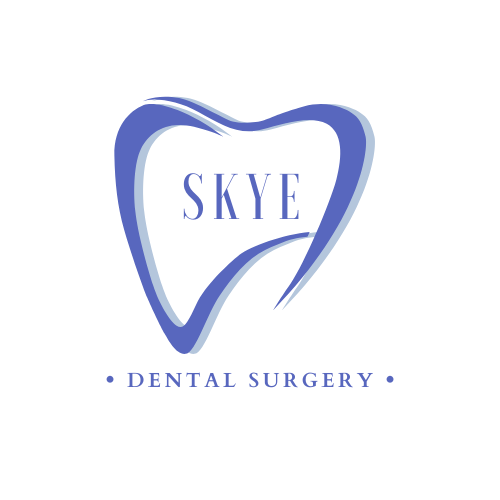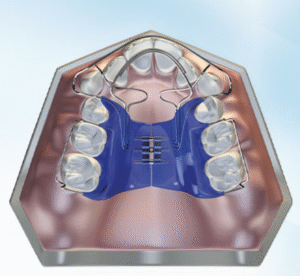
Introduction: Why Early Braces Matter More Than You Think
Many parents only think about braces when all their child’s permanent teeth have erupted. But by then, some underlying growth issues — such as narrow jaws or mouth breathing — may already be affecting their health, sleep, and confidence.Early braces treatment isn’t just about creating a beautiful smile — it’s also about guiding jaw growth, improving facial balance, and supporting better breathing and sleep.
Early Signs Your Child May Need Braces
Catching the signs early can make a world of difference. Here are some red flags that your child may benefit from early orthodontic evaluation:
- Crowded or Crooked Baby Teeth – If baby teeth are overlapping or rotated, it may signal that there’s not enough space for adult teeth to come in properly.
- Mouth Breathing or Snoring – Constant mouth breathing, especially during sleep, could mean your child’s airway is narrow or restricted.
- Underbite, Overbite, or Crossbite – When the jaws don’t align properly, it can affect chewing, speech, and facial balance.
- Thumb Sucking or Prolonged Pacifier Use – These habits can narrow the upper jaw and push teeth out of position.
- Speech Difficulties or Lisping – A misaligned jaw or tongue posture can affect how sounds are formed.
- Grinding Teeth During Sleep – Sometimes linked to airway restriction or poor oxygen flow during sleep.
- Tiredness or Poor Sleep Quality – If your child snores, sleeps restlessly, or wakes up tired, it could be connected to airway issues.
If you notice a few of these signs, it doesn’t always mean braces are needed immediately — but it’s worth a check-up with a dentist experienced in early orthodontic care.

The Link Between Jaw Growth, Airway, and Sleep
One of the biggest advances in modern dentistry is understanding how jaw growth affects breathing and sleep.
Here’s how these systems work together:
-
Jaw structure and airway size
The upper jaw forms the base of the nose. If the upper jaw is narrow or underdeveloped, nasal passages are smaller — making it harder to breathe through the nose.
A smaller lower jaw can also push the tongue backward, reducing airway space during sleep.
-
Mouth breathing and facial growth
When a child breathes through the mouth, the tongue stays low and doesn’t support the palate. Long-term mouth breathing can also affect facial development — children who breathe through their mouths often develop longer faces, weaker jawlines, and narrower dental arches. Some common signs include:
- Narrow dental arches
- Longer facial shape
- Crowded teeth
- Poor lip closure
- Low oxygen intake
Children with airway issues may experience snoring, restless sleep, or even mild sleep apnea.
Look for symptoms like:
- Frequent tossing and turning
- Bedwetting after age 6
- Daytime tiredness or irritability
- Dark circles under the eyes
- Mouth open during sleep
Early braces treatment that improves jaw shape can expand the airway, enhance nasal breathing, and reduce sleep-related issues — improving concentration and mood in daily life. Early intervention helps ensure the jaws develop in harmony — giving your child not only a straighter smile but also better oxygen flow and quality sleep.
Early Treatment Options for Children
At Skye Dental Penang, our dentists personalize every plan according to your child’s growth pattern, airway health, and dental development.
Here are the most common early interventions we use
1.Myofunctional or Habit Correction Therapy
This approach trains facial muscles and tongue posture to support natural jaw development and nasal breathing.
Using gentle exercises and systems like Myobrace®, children learn:
- How to keep their lips closed
- How to rest the tongue correctly
- How to breathe through the nose
- How to align teeth naturally over time
It’s a preventive, non-invasive approach that targets the cause, not just the symptoms.
Modern early orthodontic treatments go beyond cosmetic alignment. They’re designed to support natural facial growth and airway health.
2.Expanders
For children with narrow upper jaws, a palatal expander is one of the most effective tools in early braces treatment. This gentle device works by gradually widening the upper dental arch — not by forcing movement, but by guiding the natural growth of the mid-palatal suture (the soft growth line in the roof of the mouth).
A palatal expander helps by gently widening the jaw, which has two major benefits:
- Creates more room for teeth – allowing adult teeth to erupt naturally without the need for extraction.
- Improves airflow and breathing – as the palate expands, the floor of the nasal cavity widens too, making it easier for your child to breathe through the nose instead of the mouth.
Better nasal breathing means more oxygen, deeper sleep, and even improved facial balance. Children who switch from mouth to nose breathing often show better posture, focus, and energy during the day.
At Skye Dental Penang, we offer several types of expanders depending on your child’s needs:
a). Invisalign Palatal Expander (IPE)
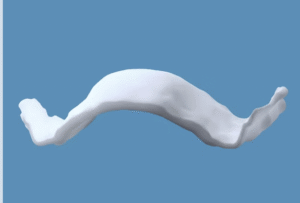
A removable, clear device that gradually widens the upper jaw using digital precision. It’s comfortable, easy to clean, and suitable for children as young as 6 or 7.
Benefits:
- Expands airway space
- Promotes nose breathing
- Makes room for incoming teeth
b) Bioblock Orthotropic Appliance
A functional appliance that encourages the jaw to grow forward rather than downward. This forward growth supports better facial balance and airway openness.
Ideal for:
- Mouth breathers
- Children with retrusive (backward-positioned) jaws
- Improving facial harmony naturally
c). Hyrax Expander
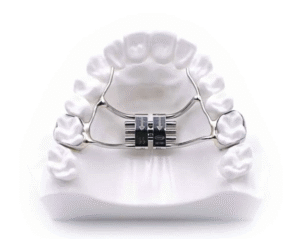
A fixed appliance used to widen the upper jaw, typically for more significant expansion needs. It’s effective for correcting crossbites and improving nasal airflow.
Advantages:
- Creates room for permanent teeth
- Helps open nasal passages
- Often part of a phased treatment plan
Each option is carefully chosen based on your child’s age, growth pattern, and breathing habits.
3. Braces
Traditional braces remain one of the most effective and reliable tools in early interceptive care — especially for guiding tooth eruption and correcting bite discrepancies before they become more complex.
For children, early braces are often used in short, gentle phases to guide growth rather than perform full alignment. These small adjustments help ensure the teeth and jaws develop in balance with the child’s facial structure and airway.
Benefits of early braces include:
-
Aligning teeth to create proper spacing for incoming permanent teeth.
-
Correcting bite issues such as crossbites, underbites, or overbites that may interfere with chewing or jaw growth.
At Skye Dental Penang, we use light-force brackets for better comfort. Some children may also have partial braces limited to the front teeth or specific sections of the arch — a method known as limited braces or 2 by 4 — to minimize discomfort while achieving functional results.
When used early, braces can reduce or even eliminate the need for major orthodontic work later on, as they set the foundation for proper jaw and tooth alignment from the start.
4. Clear Aligners – Invisalign First / Angel Aligner
Clear aligners are becoming a popular and child-friendly option for early orthodontic correction. Systems like Invisalign First and Angel Aligner Kids are specially designed for growing children with mixed dentition (a combination of baby and adult teeth).
These aligners offer a gentle and aesthetic alternative to traditional braces — perfect for children who are self-conscious or prefer a removable appliance.
Key benefits of clear aligners for early treatment:
-
✅ Removable and easy to clean – allowing better oral hygiene and no food restrictions.
-
✅ Comfortable and discreet – no sharp brackets or wires that can irritate cheeks.
-
✅ Custom-fit digital design – planned using 3D scans to guide each tooth movement precisely.
-
✅ Promotes nasal breathing and proper jaw function – when combined with airway-focused therapy.
Clear aligners can correct mild crowding, improve bite relationships, and help guide erupting teeth into their correct positions.
For some patients, dentists may combine aligners with an expander (like the Bioblock or IPE) to achieve both structural growth and tooth alignment. This phased approach ensures that the child’s airway, bite, and smile develop together in harmony.
At Skye Dental Penang, we use advanced digital monitoring and growth tracking to decide when aligners are most suitable. By evaluating your child’s breathing patterns, jaw growth, and tooth eruption timing, our dentists can tailor a treatment plan that maximizes comfort and long-term results.
4.Clear Aligner- Invisalign first / Angle aligner
When Is the Best Age to Start Early Braces?
Most children benefit from an initial orthodontic screening around age 6–8. This doesn’t always mean treatment starts immediately — but early evaluation gives your dentist a chance to spot subtle growth or airway issues early on.
If needed, early intervention can:
- Reduce the need for future extractions
- Prevent jaw surgery in teenage years
- Improve breathing and sleep quality
- Guide permanent teeth into a healthier position naturally
The goal isn’t to “rush braces,” but to support natural growth at the right time.
How Mouth Breathing Affects Development
Many parents don’t realize mouth breathing isn’t just a habit — it’s often a sign of an airway problem.
When a child breathes through their mouth instead of the nose, it can lead to:
- Dry mouth and increased cavities
- Narrow upper jaw and dental crowding
- Flattened facial profile over time
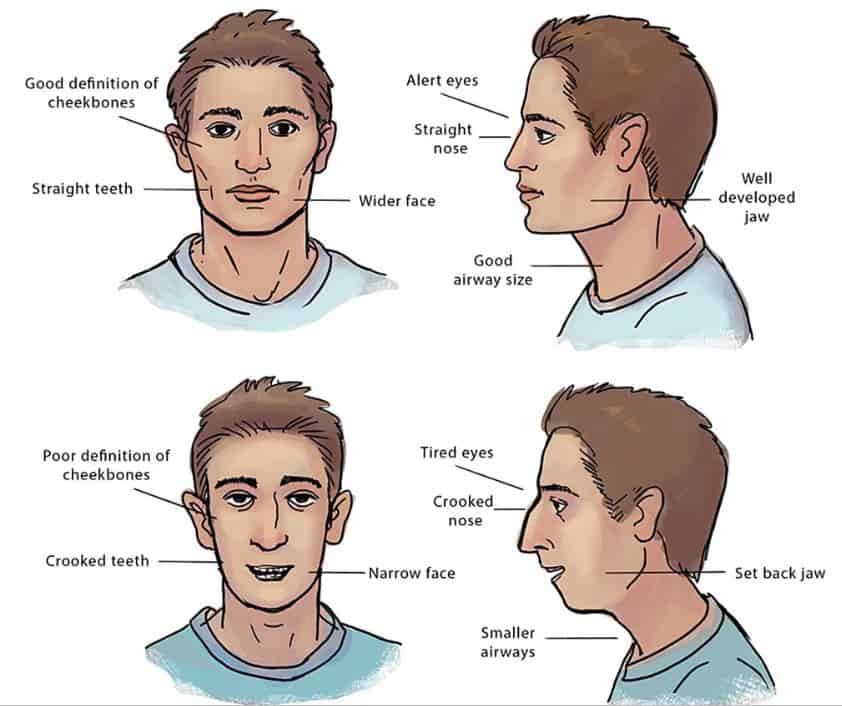
By helping a child breathe through their nose early, dentists can set the foundation for better oral and overall health.
Early Braces vs. Waiting Until Teen Years
| Aspect | Early Braces (Age 6–10) | Later Braces (Teen Years) |
| Jaw Growth | Still growing, easier to guide | Growth mostly complete |
| Airway Development | Can improve breathing early | Airway correction is limited |
| Tooth Extraction Risk | Usually reduced | Often higher |
| Treatment Goals | Preventive & developmental | Corrective |
| Comfort & Cooperation | Shorter, gentler phases | Longer treatment time |
Early treatment isn’t always necessary, but when indicated, it can prevent more complex issues later on.
What Parents Can Expect at Skye Dental Penang
During your child’s early orthodontic consultation, our dentist will:
- Evaluate facial and dental growth using 3D scans and X-rays
- Assess airway health and breathing habits
- Discuss options like IPE, Bioblock, or Hyrax depending on your child’s needs
- Provide a personalized treatment roadmap
Our goal is to keep treatment gentle, functional, and focused on your child’s long-term health — not just straight teeth.
Final Thoughts: Growing Smiles, Growing Confidence
Early braces treatment can do so much more than improve appearance — it helps children breathe, sleep, and grow better.
If you’ve noticed mouth breathing, snoring, or misaligned teeth, it’s worth scheduling an evaluation. The earlier we understand your child’s growth pattern, the better we can guide it — naturally and safely.
Book a consultation at Skye Dental Penang today and give your child the gift of a healthy smile and restful sleep.
